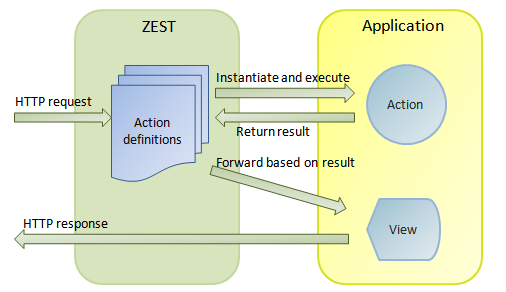Overview"
From Documentation
(Created page with "{{ZESTEssentialsPageHeader}} =Version History= {{LastUpdated}} {| border='1px' | width="100%" ! Version !! Date !! Content |- | | | |} {{ZESTEssentialsPage...") |
|||
| Line 1: | Line 1: | ||
{{ZESTEssentialsPageHeader}} | {{ZESTEssentialsPageHeader}} | ||
| + | |||
| + | ZEST is a lightweight Web framework that enables MVC and REST architectural pattern. | ||
| + | |||
| + | ZEST is installed as a HTTP filter to intercept each HTTP request. Once a HTTP request is received, ZEST looks for the matched action, instantiate and invoke it, and then forward to the view based on the result as illustrated below. | ||
| + | |||
| + | [[File:ZESTExecutionFlow.png]] | ||
| + | |||
| + | The use of ZEST is straightforward: | ||
| + | |||
| + | # Configure <tt>WEB-INF/web.xml</tt> to specify ZEST as a filter | ||
| + | # Configure <tt>WEB-INF/zest.xml</tt> to specify the definitions of actions | ||
| + | # Implement the action as a Java class to handle the request | ||
| + | # Implement the view in any technology you prefer to show up the result | ||
=Version History= | =Version History= | ||
Revision as of 10:40, 11 March 2011
ZEST is a lightweight Web framework that enables MVC and REST architectural pattern.
ZEST is installed as a HTTP filter to intercept each HTTP request. Once a HTTP request is received, ZEST looks for the matched action, instantiate and invoke it, and then forward to the view based on the result as illustrated below.
The use of ZEST is straightforward:
- Configure WEB-INF/web.xml to specify ZEST as a filter
- Configure WEB-INF/zest.xml to specify the definitions of actions
- Implement the action as a Java class to handle the request
- Implement the view in any technology you prefer to show up the result
Version History
| Version | Date | Content |
|---|---|---|
